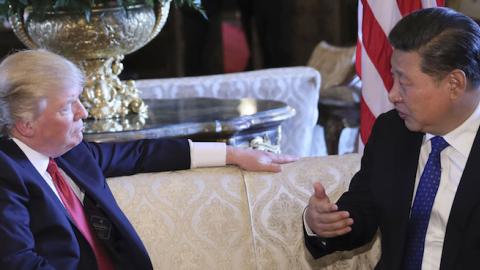The Trump-Xi summit held in Mar-a-Lago the first week of April occurred without any major results or announcements. The accusations that candidate Trump made against China during the campaign were absent. Observers who may have expected a fiery confrontation saw mostly diplomatic niceties. The meeting between the Chinese and American presidents appears to have focused primarily on two major issues: trade and the North Korea situation. The leaders of both countries emerged from the event speaking positively of their discussions, but without reaching any significant agreements. Rather, government statements and those of the media regarded the meeting as an opportunity for them to “get to know each other.”
Mr. Trump tweeted afterwards that the meeting created “tremendous goodwill and friendship.” Secretary of State Tillerson noted that the discussions were “very frank, very candid,” and “very positive.” He also emphasized that while cooperation between the U.S. and China is desirable, the U.S. would stand by its security commitments in Asia and around the world.
On trade, the two sides agreed to “100 days” of trade talks, with benchmark accomplishment goals during that time, in order to attempt to develop joint trade initiatives and to balance the trade deficit between the two countries. According to Commerce Secretary Wilbur Ross, China expressed an interest in reducing the net trade balance, as it impacts the country’s money supply and inflation. Trump called for reciprocal market access between the two states, in order to “level the playing field for American workers.” China expressed a willingness to give the U.S. greater market access in beef exports and financial sector investments.
On North Korea, the two leaders discussed a response to the hermit kingdom’s increasing nuclear threat. According to Secretary Tillerson, both sides agreed that the North Korea threat was urgent, and agreed to reaffirm their commitment to a denuclearized Korean Peninsula and to “fully implement UN Security Council Resolutions.” They also agreed to increase bilateral and multilateral cooperation in order to “peacefully resolve the issue” and to convince the North Koreans to end their weapons program.
Shortly before the summit began, a representative of the Trump administration, identified as “a senior administration official,” told the White House press corps that on the question of U.S. policy toward cross-straits relations, President Trump had already reaffirmed the U.S.’s commitment to the One China policy. The same official noted that the One China policy is based on three joint communiques with China as well as the Taiwan Relations Act, which calls for U.S. military assistance to Taiwan in the event of a Chinese invasion or attack. In his background briefing the Trump administration senior official anticipated no “surprising deviation from that.” There was none.
While both sides agreed to pursue further talks on an array of subjects in the future, including President Trump’s pledge to visit China later this year, no significant agreements were reached. China reportedly invited the United States to participate in its One Belt One Road initiative to develop infrastructure through Asia, linking China and the East with Europe. Other major issues of contention between the two countries, such as Taiwan and territorial disputes in the East and South China Seas, do not appear to have been addressed.
The major highlight of the summit was not anything related to the meeting itself, but the cruise missile strike by the United States on a Syrian airfield that occurred while the two leaders were having dinner. Mr. Trump reportedly informed President Xi of the strike and explained the justification behind the attack. After the summit, Chinese state media denounced the action, calling Trump “a weakened politician who needed to flex his muscles” and also hinting that he had ordered the strike in order to distance himself from Moscow and allegations that he is “pro-Russian.” A number of Chinese policy analysts also viewed the strikes as a message that the U.S. maintains the capability—and will—to launch strikes against North Korea, if necessary. The redeployment of the USS Carl Vinson Carrier Strike Group to the Korean Peninsula over the weekend could further reiterate this point. Chinese media’s account of the summit also omitted mention of the North Korea issue.
Much speculation over the talks indicate that President Xi’s goal was focused domestically, to “get the U.S. off his back” in advance of the Chinese Communist Party’s Congress meeting this year. A significant number of CCP leadership figures are expected to resign, and President Xi will likely seek to further solidify his political power. Smooth relations with the U.S. will allow him to focus primarily on these concerns.
In any competition, from chess to sports to commerce or international relations, two sides either engage one another directly and vigorously, or else they size each other up and seek to understand their opponent more thoroughly before taking significant action. The Trump-Xi summit was unusual for what did not happen at the meeting. The two leaders took each other’s measure at the same time that Mr. Trump acted vigorously elsewhere in defense of American interests, from attacking a Syrian airfield to deploying an aircraft carrier strike group in response to North Korea’s increasing provocations. Actions, as Mr. Xi certainly understands, speak louder than words.



















